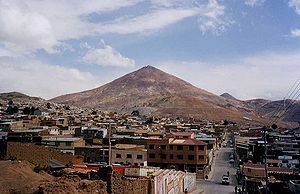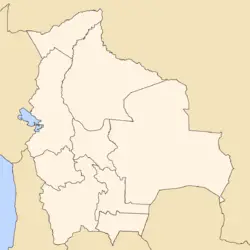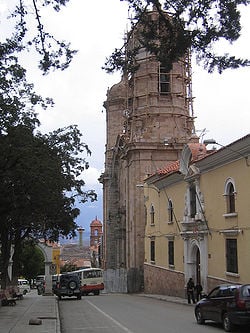Difference between revisions of "Potosí" - New World Encyclopedia
(imported and credited, categories edited) |
(images okay tag applied) |
||
| Line 1: | Line 1: | ||
| + | {{Images OK}} | ||
{{Infobox Settlement | {{Infobox Settlement | ||
<!--See the Table at Infobox Settlement for all fields and descriptions of usage—> | <!--See the Table at Infobox Settlement for all fields and descriptions of usage—> | ||
Revision as of 00:04, 12 May 2008
| Potosí | |
| Location in Bolivia | |
| Coordinates: 19°35′S 65°35′W | |
|---|---|
| Country | |
| Department | Potosí Department |
| Province | |
| Founded | April 1 1545 |
| Population (2005) | |
| - Total | 134,281 |
Potosí is a city, the capital of the department of Potosí in Bolivia. It is claimed to be the highest city in the world. It lies beneath the Cerro de Potosí — sometimes referred to as the Cerro Rico ("rich mountain") — a mountain of silver ore, which has always dominated the city. Cerro de Potosí's peak is 4,824 meters (15,827 feet) above sea level.
Origin of name
There is no satisfactory etymological study of the word Potosí. According to legend, circa 1462, Huayna Capac, the eleventh monarch of Peru, "set out for Ccolque Porco and Andaccaua, the location of his mines from which were taken innumerable arrobas of silver." (An arroba is a Spanish unit of weight equivalent to approximately 25 pounds.) "Before leaving there, he saw [Potosí], and admiring its beauty and grandeur, he said (speaking to those of his Court): 'This doubtless must have much silver in its heart'; whereby he subsequently ordered his vassals to go to Ccolque Porco ... and work the mines and remove from them all the rich metal. They did so, and having brought their tools of flint and reinforced wood, they climbed the hill; and after having probed for its veins, they were about to open those veins when they heard a frightening thunderous noise which shook the whole hill, and after this, they heard a voice which said: 'Do not take the silver from this hill, because it is destined for other masters.' Amazed at hearing this reasoning, the Incan vassals desisted in their purpose and returned to Porco and told the king what had happened; relating the occurrence in their own language, on coming to the word noise, they said 'Potocsí' which means there was a great thunderous noise, and from that later was derived (corrupting a letter) the name of potosi."
It is currently believed that the etymology of Potosí is Quechua. However, in Quechua the phoneme p'otoj does not refer to a thunderous noise, whereas it does in Aymara. Thus, if Potosí encompasses the idea of a thunderous noise, the locution would have an Aymaran root rather than a Quechuan. The actual sharp structure of the term is contrary to the nature of both Aymara and Quechua.
History
| City of Potosí* | |
|---|---|
| UNESCO World Heritage Site | |
| Type | Cultural |
| Criteria | ii, iv, vi |
| Reference | 420 |
| Region** | Latin America and the Caribbean |
| Inscription history | |
| Inscription | 1987 (11th Session) |
| * Name as inscribed on World Heritage List. ** Region as classified by UNESCO. | |
Founded in 1546 as a mining town, it soon produced fabulous wealth, becoming one of the largest cities in the Americas and the world with a population exceeding 200,000 people.
In Spanish there is still a saying, valer un potosí, "to be worth a potosí" (that is, "a fortune"). For Europeans, Peru — Bolivia was part of the Viceroyalty of Perú and was known as Alto Perú before becoming independent — was a mythical land of riches. Potosí appears as an idiom for "extraordinary richness" in Miguel de Cervantes' famous novel satirizing chivalry, Don Quixote (second part, cap. LXXI). One theory holds that the mint mark of Potosí (the letters "PTSI" superimposed on one another) is the origin of the dollar sign.
It is from Potosí that most of the silver shipped through the Spanish Main came. According to official records, 45,000 tons of pure silver were mined from Cerro Rico from 1556 to 1783. Of this total, 7,000 tons went to the Spanish monarchy. Indian labour, forced by Francisco de Toledo, Count of Oropesa through the traditional Incan mita institution of contributed labor, came to die by the thousands, not simply from exposure and brutal labor, but by mercury poisoning: in the patio process the silver-ore, having been crushed to powder by hydraulic machinery, was cold-mixed with mercury and trodden to an amalgam by the native workers with their bare feet. [1] The mercury was then driven off by heating, producing deadly vapors.
To compensate for the diminishing indigenous labor force, the colonists made a request in 1608 to the Crown in Madrid to begin allowing for the importation of 1500 to 2000 African slaves per year. An estimated total of 30,000 African slaves were taken to Potosí throughout the colonial era. African slaves were also forced to work in the Casa de la Moneda as acémilas humanas (human mules). Since mules would die after couple of months pushing the mills, the colonists replaced the four mules with twenty African slaves. (Angola Maconde 1999)
After 1800 the silver mines became depleted, making tin the main product. This eventually led to a slow economic decline. Still, the mountain continues to be mined for silver to this day. Due to poor worker conditions (lack of protective equipment from the constant inhalation of dust), the miners still have a short life expectancy with most of them contracting silicosis and dying around 40 years of age. It is estimated that, in the past years of indigenous labour, roughly 8 million Indians died, "eaten" by the Rich Hill.[2]
During the War of Independence (1809–1825, see History of Bolivia) Potosi frequently passed between the control of Royalist and Patriot forces. Major blunders by the First Auxiliary Army from Buenos Aires (under the command of Juan José Castelli) led to an increased sense that independence was needed and fostered resentment towards him. During that occupation there was anarchy and martial excess, and Potosi became unfriendly to the point where it could not be defended.
When the second auxiliary army arrived it was received well, and the commander, Manuel Belgrano did much to heal the past wounds inflicted by the tyrannical minded Castelli. When that army was forced to retreat, Belgrano took the calculated decision to blow up the Casa de Moneda. Since the locals refused to evacuate this explosion would have resulted in many casualties, but by then the fuse was already lit. Disaster was averted not by the Argentinians who at that time were fleeing, but by locals who put the fuse out. Two more expeditions from Buenos Aires would seize Potosí.
The city of San Luis Potosí in Mexico was named after Potosí in Bolivia. In the United States, the name Potosi was optimistically given to lead-mining towns of Potosi, Wisconsin[1] and Potosi, Missouri, and also to the silver-mining town of Potosi, Nevada.
ReferencesISBN links support NWE through referral fees
- Angola Maconde, Juan. "Raíces de un pueblo: cultura afroboliviana." La Paz: Producciones CIMA, 1999.
- Arzáns de Orsúa y Vela, Bartolomé. Historia de la Villa Imperial de Potosí. Edición de Lewis Hanke y Gunnar Mendoza. Providence, R.I.: Brown University Press, 1965.
- Cobb, Gwendolin Ballantine. "Potosí, a South American Mining Frontier." Greater America: Essays in Honor of Herbert Eugene Bolton. Freeport, N.Y.: Books for Libraries Press, 1968, © 1945, pp. 39-58.
- Hanke, Lewis. The Imperial City of Potosí. The Hague: Nijhoff, 1956.
External links
- Potosi Potosi, everything on the city of Potosi, tourism, history
- Potosí City Guide
- Cerro Rico 2003
- The Devil's Miners - A documentary about child miners in Potosí
- Travelogue Potosí
- The Mountain That Eats Men - Slate Magazine
- Photographs of Potosi and environs
- Scream of the stone - scene from a documentary about depleting mines in Potosí and its social consequences
- [2] fertility rite held in different parts of Potosi
| |||||||
Credits
New World Encyclopedia writers and editors rewrote and completed the Wikipedia article in accordance with New World Encyclopedia standards. This article abides by terms of the Creative Commons CC-by-sa 3.0 License (CC-by-sa), which may be used and disseminated with proper attribution. Credit is due under the terms of this license that can reference both the New World Encyclopedia contributors and the selfless volunteer contributors of the Wikimedia Foundation. To cite this article click here for a list of acceptable citing formats.The history of earlier contributions by wikipedians is accessible to researchers here:
The history of this article since it was imported to New World Encyclopedia:
Note: Some restrictions may apply to use of individual images which are separately licensed.






